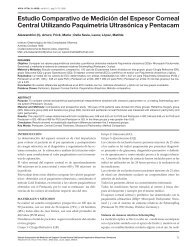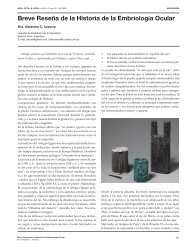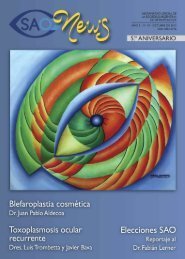Volumen 79 Número 1 - Sociedad Argentina de Oftalmología
Volumen 79 Número 1 - Sociedad Argentina de Oftalmología
Volumen 79 Número 1 - Sociedad Argentina de Oftalmología
Create successful ePaper yourself
Turn your PDF publications into a flip-book with our unique Google optimized e-Paper software.
ABSTRACT<br />
Objective: To study type and level of immunologic response to different infectious agents in early childhood<br />
of 3- months of age with congenital dacryostenosis.<br />
Methods: Concentration of immunoglobulins (IgA, IgM and IgG: IDRS; IgE and IgG subclass: ELISA) were<br />
studied in tears of early childhood without dacrioestenosis (uninfected controls) and with dacrioestenosis<br />
and infected with coconuts, bacilli or virus <strong>de</strong>tected by bacteriological culture and inmunostain with<br />
monoclonal antibodies.<br />
Results: the concentration of IgA was increased markedly by bacilli but it was smaller in front of coconuts<br />
and virus. The increase of IgM response was similar in the three groups. With regard to the second <strong>de</strong>fense<br />
line it was observed that coconuts and virus tilting the immune response to Th2 isotypes (IgE and IgG4)<br />
which did not protect against the infection. Although bacilli induced something of Th2 isotypes they also<br />
generated a good response of Th1 isotypes (IgG1 and IgG3) which protects against infection.<br />
Conclusion: early childhood of 3- months with congenital dacryostenosis had good first and second<br />
<strong>de</strong>fense barrier against bacilli. In contrast coconuts and virus induce a tilting to immunity Th2, which do not<br />
protect against infection.<br />
Key words: Congenital dacryostenosis, infection, immunoglobulins, Th1 vs. Th2 isotypes in tears<br />
Introducción<br />
La importancia <strong>de</strong> la inmunidad regional adquiere<br />
cada vez mayor atención entre los investigadores.<br />
Esto se <strong>de</strong>be a que ha sido <strong>de</strong>mostrado<br />
que cada órgano o sistema tiene características<br />
que le son propias, las cuales pue<strong>de</strong>n influenciar<br />
el <strong>de</strong>sarrollo local y sistémico <strong>de</strong> la respuesta inmune<br />
<strong>de</strong> manera particular 1 .<br />
La conjuntiva y sus secreciones están preparadas<br />
para montar una respuesta inmunológica<br />
activa para evitar la entrada <strong>de</strong> microorganismos,<br />
alergenos y partículas extrañas en general<br />
2 . El tejido subconjuntival contiene abundantes<br />
linfocitos B capaces <strong>de</strong> diferenciarse a células<br />
plasmáticas secretoras <strong>de</strong> IgA frente a interleuquinas<br />
(IL) como TGF ß e IL , ambas con gran<br />
actividad en tejidos relacionados a mucosas.<br />
Esta IgA, que es liberada a la secreción lagrimal<br />
como IgA secretoria a través <strong>de</strong>l epitelio <strong>de</strong> las<br />
glándulas lagrimales es uno <strong>de</strong> los primeros mecanismos<br />
<strong>de</strong> <strong>de</strong>fensa <strong>de</strong> la superficie ocular. En<br />
esta primera línea también tienen un rol los anti-<br />
Primera infancia y dacrioestenosis congénita:<br />
marcada <strong>de</strong>sviación hacia respuesta no protectiva<br />
Th2 frente a ciertas infecciones conjuntivales<br />
cuerpos naturales, principalmente tipo IgM, que<br />
tienen la característica <strong>de</strong> ser oligoespecíficos, <strong>de</strong><br />
baja afinidad y liberados en respuesta a antígenos<br />
timo-in<strong>de</strong>pendientes como por ejemplo los<br />
polisacáridos bacterianos.<br />
Cuando esta primera línea <strong>de</strong> <strong>de</strong>fensa falla<br />
ya sea por <strong>de</strong>ficiente producción <strong>de</strong> sus moléculas<br />
<strong>de</strong> <strong>de</strong>fensa o por exceso <strong>de</strong> oferta <strong>de</strong> antígenos,<br />
microorganismos, alergenos y/o sustancias<br />
tóxicas, estos encuentran la puerta abierta para<br />
la producción <strong>de</strong> procesos inflamatorios en conjuntiva.<br />
Entonces se pone en marcha la segunda<br />
barrera <strong>de</strong> <strong>de</strong>fensa <strong>de</strong> la superficie ocular. En ella<br />
las células <strong>de</strong> Langerhans (células presentadoras<br />
<strong>de</strong> antígeno) captan los antígenos, los procesan<br />
y migran a los folículos linfáticos subepiteliales<br />
don<strong>de</strong>, diferenciadas a células <strong>de</strong>ndríticas producen<br />
la activación <strong>de</strong> los linfocitos. Estas células<br />
presentadoras <strong>de</strong> antígeno juegan un rol clave<br />
pues según el antígeno y el sistema inmune <strong>de</strong>l<br />
huésped, dirigirá a los linfocitos T cooperadores<br />
[ 49 ]






